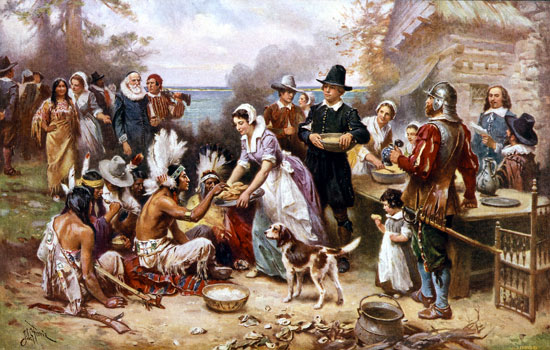How Did the Cranberry Become Part of our Thanksgiving?

We don't have photographs of the first Thanksgiving in 1621,
but we know that the Native Americans shared with the early settlers in this celebration.
In the Northeast of the United States Cranberries grew wild and the Native Americans used them not only eating but for dye for their clothing, rugs and blankets. So this is probably when it started.
Some Other Facts on Cranberries
1. Cranberries are one of only three fruits that are native to North America. It's a wild fruit that grows on long-running vines in sandy bogs and marshes, mostly in the Northeast, but also in the Pacific Northwest.
2. Native Americans were the first to enjoy cranberries. They mixed deer meat and mashed cranberries to make pemmicana—a survival food. They also believed in the medicinal value of cranberries—long before science discovered cranberry's health benefits.
3. Native Americans also used the rich red juice of the cranberry as a natural dye for rugs, blankets and clothing.
4. Cranberries were called “sassamanesh” by Eastern Indians. While the Cape Cod Pequots and the South Jersey Leni-Lenape tribes named them “ibimi,” or bitter berry. It was the early German and Dutch settlers who started calling it the “crane berry” because the flower looked a lot like the head and bill of a crane.
5. It wasn't until the 1800's that people began farming cranberries. At first growers would pick the cranberries by hand. Today most cranberries are harvested using a technique known as wet harvesting. That's when the bog is flooded with water and the cranberries float to the surface, where they are easily scooped up.
6. Sailors once used cranberries as a source of vitamin C to prevent scurvy. Besides Vitamin C, we now know that cranberries are also full of antioxidants that help cleanse and purify the body.
7. Some cranberry bogs are more than 100 years old and still produce today.
9. Americans consume some 400 million pounds of cranberries a year, 20 percent during Thanksgiving week.
9. American recipes containing cranberries date from the early 18th Century.
Thoughts on the History of Cranberries
“It has been an unchallengeable American doctrine that cranberry sauce, a pink goo with overtones of sugared tomatoes, is a delectable necessity of the Thanksgiving board and that turkey is inedible without it.”
-Alistair Cooke
Alistair Cooke, a legendary British-American journalist, writer and broadcaster who just a few years ago, to the great poverty of us all, passed away, graciously and unwittingly provided us with today's quote. Of course, his legacy is considerably greater than that of an obscure observation concerning cranberries, but for our purposes, which are as quintessentially plump and juicy as our subject of mention; this will have to suffice as this column's one and only homage to a great man.
Well, and if this is the first installment of Chez Ché, perhaps we can be forgiven.
Also, Alistair Cooke might have been kinder to the cranberry, one of just a scattered few of North America’s native fruits that are used in our traditional and cultural recipes, had he known that the fruit was immortal. Oh, the berries themselves are as vincible as you or I, as mercurial and fleeting as any other life this planet has begotten – in evidence I present craisins , a snack and handy salad garnish more withered and pruned than any of our centenarians. But the vines themselves, if left to their own devices and allowed to flourish undamaged, can survive indefinitely without even a hint of reducing their yield. There are vines in Massachusetts, in fact, that have survived a century and a half and show no sign of slowing. Eat your heart out, Energizer Rabbit.
